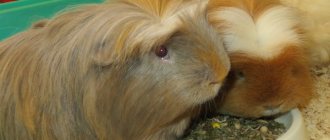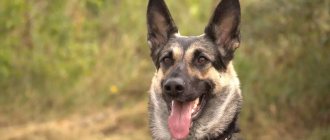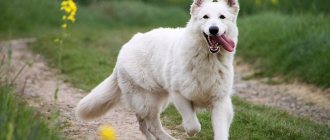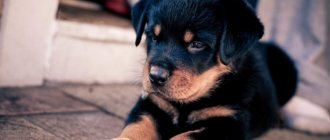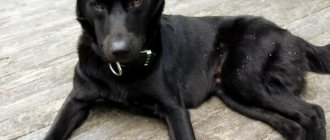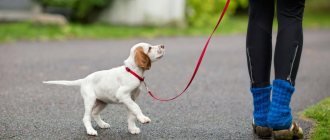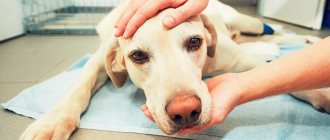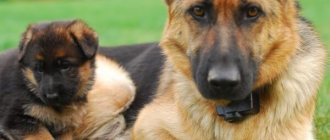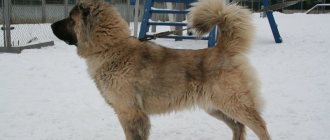The East European Shepherd is one of the breeds that were bred in the former Soviet Union - thus dog handlers wanted to give rescuers, military and law enforcement agencies worthy helpers.
If you look at a photo of an East European Shepherd or meet a live dog, an association with the German breed immediately arises in your imagination - a similar build, muzzle, color. In this case, you will not be mistaken - to breed the East European Shepherd, it was the Germans who were used as the starting step.
East European Shepherd dog standing
History of the East European Shepherd breed
Like most domestic service breeds, East European Shepherds were bred in the 30-50s of the 20th century, due to state necessity.
By the way, the expression “state necessity” meant guard and escort service in the Gulag, which for obvious reasons was not advertised. The breeding material for creating the next superdog was German shepherds, thanks to which several breed lines were formed in the USSR. In particular, the most sought-after offspring were those from imported males such as Edu von Heisenhof, Edie von Blumenduft and Devete von Furstensteg. After the Great Patriotic War, the VEO population in Soviet nurseries was reduced to a critical minimum, which is why work on the development and improvement of the breed had to start from scratch. However, already in the 60s, seven new breeding lines appeared in the country, the representatives of which demonstrated outstanding service and exterior qualities. The era of Stalinist camps and prisons had by that time become part of history, so animals began to be recruited for service in the Ministry of Internal Affairs, and also used as guide dogs. Domestic cinema also fueled interest in the breed. After the release of the films “Come to me, Mukhtar!” and “Border Dog Scarlet” almost every second Soviet schoolchild dreamed of acquiring an East European Shepherd.
In 1964, the first full-fledged appearance standard was drawn up for the “Easterns,” which provided them with recognition first by the Union of Cynological Organizations of Russia, and later by the RKF. As for similar foreign and international communities, not all of them agreed to consider VEO as a separate breed. For example, FCI still positions East European Shepherds as the Russian branch of German Shepherds: updated and improved, but generally retaining the phenotype and psychological traits of their ancestor.
What to feed
Avid dog lovers and experienced dog handlers know the saying: “The breed enters through the mouth.” The external data or exterior of the VEO puppy, the pet’s health, growth and full development depend on proper feeding. Feeding the puppy is consistent with the baby's growth rate.
A puppy settling into a new living space, getting used to its owner, experiences stress. In the initial days, it is better to adhere to the feeding regime that was practiced by the breeders running the nursery. Even food and feed should be selected with an eye to feeding in the nursery. As a rule, breeders are happy to advise the owner on emerging issues.
The puppy’s diet depends on the age periods associated with the energy costs of the growing body. There are two known types of feeding: natural products and ready-made factory feeds. In the first case, the owners will need to ensure that many foods are included in the diet and that the diet remains balanced. In the second, everything has already been thought out for the owners. Industrial quality food already contains the nutrients, vitamins and minerals your puppy needs.
- The one-month-old puppy VEO needs to be fed 6 times a day.
- The VEO puppy, 2 months old, receives 5 meals a day.
- At three months of age, the puppy is fed 4 times.
- A six-month-old puppy is taught to eat 2 meals a day.
If the puppy is active, he is trained or kept in harsh conditions (outdoors in an enclosure, even in winter), the need for food increases due to increased energy costs. But the diet of the “Eastern” is supposed to be balanced, able to replace the loss of energy after exercise and exercise. From now on, nutritious food is available to all breeds.
If, when deciding what to feed your East European Shepherd puppies, you decide to opt for dry food, do not forget to make sure there is fresh water in the animal’s bowl. Food is chosen taking into account the age and breed of the pet. Don’t forget to change your diet, reduce the number of feedings, and the size of portions as your dog gets older.
It is possible to feed a mature East European Shepherd with dry food or prefer a diet with products of natural origin. It is better to feed an adult dog twice a day.
Regardless of the method you choose, monitor and supplement your dog's diet with vitamins and mineral supplements. If your work schedule leaves little free time, it is better to prefer a diet based on dry food, selected according to the dog’s structural features. The health of your pet depends on proper nutrition. Representatives of the species are predisposed to diseases:
- allergy;
- joint disease;
- If you eat improperly, stomach problems often occur.
To protect your dog from diseases, introduce the correct daily routine, with obligatory long walks and physical activity. Exclude from your diet:
- Sweets. It is better not to give your pet any chocolates, sweets or other goodies. Give your dog a piece of cheese as a treat, or buy special sweets for dogs at the pet store.
- Fat meat. Meat containing excess fat is difficult to digest. It is better to replace fatty pork with veal or boiled beef.
Breed standard of the East European Shepherd and differences from the German
Considering that the purebred VEO is, in fact, a “Russified” German shepherd, one cannot count on cardinal external differences between the breeds. Nevertheless, if you put an exemplary “German” and his Soviet descendant side by side, it is quite possible to identify each. Usually the first thing that catches your eye is the impressive build of the “Eastern”. As an example: the average male German Shepherd has the same height and weight as an Eastern European female, and this despite the fact that both breeds are characterized by sexual dimorphism. According to the breed standard, the height of the East European Shepherd at the withers is 66-76 cm for males, 62-72 cm for females. The weight of “boys” and “girls” is 35-60 kg and 30-50 kg, respectively.
An important nuance is the line of the back. For the “Germans” it is strongly sloping (the angle of inclination is about 23°), while for the “Easterns” the top looks almost horizontal. VEO's legs are much thicker and more massive than those of his ancestor. Hence the differences in movement. German Shepherds move at a short, shooting trot with a long stride, while Eastern European dogs move at a more sweeping and heavy pace.
Head
The skull is flattened, widened between the ears, with a shallow longitudinal groove. The brow and occipital protuberance are weakly marked. The stop is moderate, without harshness. The muzzle of the East European Shepherd is wedge-shaped, narrowed in the area of the lobe, but not pointed.
Jaws and teeth
The jaws of the East European Shepherd are powerful, with a full set of 42 large teeth. The only type of bite allowed by the standard is “scissors”.
Nose
The bridge of the nose is smooth, the lobe is massive, coal-black.
Eyes
The eyes of the East European Shepherd are medium in size, regular oval in shape, set slightly obliquely and very wide. The desired color of the iris is as dark as possible.
Ears
Medium in size, erect, with a triangular ear shape and a rounded tip. The ears are set wide and above eye level; in a calm dog they can take a slightly hanging position, in an alert dog they are raised strictly vertically.
Neck
Set to the back at an angle of 40° to 45°, gradually widening towards the shoulders. In purebred individuals, the necks should be muscular, without dewlap.
Frame
The body of the East European Shepherd is balanced, rectangular and moderately stretched. The back is strong, almost straight, elongated. The loin is slightly convex, short and massive. Well drawn: the line of the withers and the wide rounded croup. The chest of representatives of this breed is oval, reaching to the elbows, with neatly curved ribs. The belly is moderately tucked.
Limbs
VEO has straight, parallel legs, with the hind legs noticeably drawn back. The shoulder blades and humerus are elongated and obliquely located. The angle of the glenohumeral joint is approximately 100°. The animal's forearms are straight, turning into elbows tightly pressed to the sides and long springy pasterns, standing at a slight angle.
The hind limbs look more massive due to the muscular thighs. The dog's shins are moderately long, but not excessively elongated, the metatarsals are strong, almost vertical. The Easterners' paws have a classic oval shape with balled paws and dense black pads.
Tail
Descending to the hocks or below, saber-curved. A calm dog's tail is lowered down, while an excited dog's tail is raised (by about ⅔) to the top line of the back.
Wool
The coat of East European Shepherds is double, formed by a dense soft undercoat, which has a lighter tone, and a hard, semi-long coat, which is darker in color. Areas with abundant long hair are the neck and hips; with the shortest possible length – the head, the front of the legs, the surface of the paws and fingers.
Color
East European Shepherds can be black and tan, black or black and gray. The following colors are also allowed by the standard: black with lightened areas (marks above the eyes, on the paws, cheekbones, under the tail), black and tan and zoned gray. Not welcome, but zonular red color is also possible.
Disqualifying faults
- Floppy ears.
- Various bite deviations, including a skewed jaw.
- Incomplete dental formula.
- A suit that goes beyond the standard.
- Insufficiently pigmented lobe.
- Wool devoid of undercoat.
- Too short tail.
- Albinism.
- The presence of a cataract, heterochromia or blue iris.
- Curly, excessively long or short hair.
- A weaving, rolling gait.
- Cryptorchidism.
- Unreasonable anger and cowardice.
VEO height and weight chart
| Age (in months) | Height at the withers of a male dog (cm) | Height at the withers of the bitch (cm) | Weight (kg) |
| 1 | 23-27 | 23-25 | 3-5 |
| 2 | 35-38 | 33-36 | 8-10 |
| 3 | 43-47 | 41-46 | 12-15 |
| 4 | 50-55 | 48-53 | 15-20 |
| 5 | 55-60 | 55-57 | 20-25 |
| 6 | 60-65 | 57-65 | 25-30 |
| 7 | 65-68 | 65-66 | 30-35 |
| 8 | 68-70 | 66-67 | 35-40 |
| 9 | 68-73 | 66-68 | 35-40 |
| 10-12 | 68-75 | 66-69 | 35-40 |
Changes also occur in other parameters of the shepherd dog.
Character of the East European Shepherd
The average “Eastern” is more phlegmatic and reasonable than his German relative. He is not harsh or quick-tempered, which in case of danger does not prevent the animal from making a decision and acting with lightning speed. Well, to be more precise, the East European Shepherd is a dog that does not like the aimless manifestation of any qualities. The whole being of this serious, tireless servant strives to be useful to the owner. Accordingly, if you do not need either a vigilant watchman or a prudent security guard, finding an alternative type of activity for the VEO will not be easy.
East European Shepherds do not favor strangers, and this hostility is ineradicable. At the same time, the dog will not rush at a stranger as soon as he appears in sight. Yes, the animal is ready to protect its owner 24 hours a day, but only when the threat is really real. However, clarification is necessary here: well-trained individuals behave so restrainedly, the owner of which was not too lazy to go through the OKD with them. With young dogs that have not learned to manage their own emotions, it is better to keep your finger on the pulse. These “comrades” are not yet able to distinguish between a friendly pat on the shoulder and a full blow, and noisy companies from gangs of hooligans, so they can turn on the defender mode at the most inopportune moment.
Another pleasant bonus for fans of East European Shepherds is that male dogs do not have the habit of competing with their owner for the status of alpha male. With proper upbringing, the breed willingly hands over the reins to humans, easily getting used to the status of a companion and observing the necessary subordination. The only thing is that you will have to assign roles in the house immediately after the puppy appears in it. If this is not done in a timely manner, the East European Shepherd will have reason to suspect the owner of lack of character. And this is a direct path to disobedience, stubbornness and, ultimately, to a dangerous confrontation between owner and pet.
In general, East European Shepherds have a temperate character, as evidenced by their good-natured attitude towards children. The dog also does not harm the pets with whom she had to grow up. But VEO can get angry with stray cats and dogs, so on walks it is better to take your pet’s interest in other four-legged creatures under personal control.
Features of character and behavior
The East European Shepherd is an example of a fearless, reliable, confident dog, controlling any situation from beginning to end, movements are smooth and free. Type – strong, balanced, agile.
- Very loyal to their owner, these dogs can show aggression in unfamiliar situations if, in their assessment, the owner is in danger. The owner must take into account this feature of the breed and control his emotional state.
- Dogs are excellent at “reading” human signals, and at the slightest suspicion of a threat, they can display a protective reaction. Considering that a strong relationship is created with the owner, the decision to adopt an East European Shepherd must be approached very carefully. If it is not possible to establish contact, it will be difficult to give the animal to other conditions without damaging its psyche.
A dog often chooses one owner for life and, subject to proper training, treats other family members neutrally.
- She is tolerant with other dogs and animals after OKD.
- Among other character traits, an outstanding mind and a high ability to learn and master discipline stand out. Dogs know how to work hard, and their performance in training is at a high level.
Advantages
Among the main advantages of the East European Shepherd, it is necessary to separately mention the following:
- These dogs have first-class watchdog qualities and are an ideal option for guarding a private home.
- They are very observant, have amazing instincts, and are able to instantly navigate a situation.
- Always ready to act to protect the owner.
- Balanced, not prone to escape.
- A high level of trainability, inherited from German shepherds.
Flaws
Despite its excellent characteristics, the East European Shepherd, like any service dog, requires special treatment.
- They may be wary of new family members. However, with regular increased loads and training, they become excellent friends.
- The dog is psychologically stable, but given its developed watchdog qualities, it is considered that it is not suitable for novice dog breeders who have no experience interacting with large service breed dogs.
- Also, the East European Shepherd is not suitable for people with a soft character . In these cases, it will pose a serious problem both for the owner and his family members, and for others.
- Given the large size of the dog, it will be difficult to cope with it. During a walk, he may not obey commands and show aggression towards other dogs and animals. Training in this case will only partially solve the problem, since the dog will obey the trainer, while in his absence, cultivate an aggressive style of behavior.
- Many trainers prefer not to work with these dogs precisely because of their incredible tenacity. However, the East European Shepherd cannot be called wayward. After all, the ability to clearly and quickly perform a security task are those traits that were specially bred through selection.
As one of the shortcomings, cases of unfriendly attitude towards children aged from 3 to 5 years were noted. However, with a competent and timely training course, problems do not arise.
Education and training
In terms of learning, East European Shepherds are solid good students. They are smart, willingly delve into the essence of the actions explained to them and do not confuse reality with the situations simulated by the dog handler on the training ground. VEOs easily deal with basic OKD commands and learn the basics of ZKS with no less enthusiasm, but this is not the breed that masters the material once and for all. As dog handlers like to say: the East European Shepherd learns and trains throughout its life. This is the only way to really control the animal and not have to fear for the safety of others. Accordingly, when introducing such a brutal pet into your home, you need to be prepared for the fact that training and repetition of the material covered will become an integral part of your life.
Important: the East European Shepherd considers its owner not the one who brings him a bowl of food every day, but the person who trains it, so it is better to train the pet on your own, consulting a professional dog handler only in the most difficult situations.
Up to two months, an East European Shepherd puppy is socialized, that is, the dog must get used to its place of residence, owners, sounds and smells that accompany it at home. From the age of two months, learning of elementary commands and obedience lessons begins, which will at the same time prepare for the upcoming OKD. At this age, the baby will have to learn a new rule: before performing an action, it is necessary to obtain the owner’s permission. By the way, it is possible to fully train a shepherd dog only if it understands and recognizes the authority of the owner. When playing with your VEO puppy, do not let him win. The baby regards this behavior as a weakness that he will not hesitate to take advantage of.
The age of 4 months is the optimal period for learning more complex commands from the same OKD with the East European Shepherd. If everything is planned correctly, by 6 months the puppy will be ready to pass the course standards and will be able to begin engaging in security activities. True, up to a year, the skills and abilities acquired by the pet will have to be further honed and brought to perfection. As noted earlier, repetition of material for the breed is an urgent need.
For owners planning a sports career for their pets, we can recommend the international IPO course. However, it is worth understanding that such programs from the impressive and, what’s more, heavy “Easterners” go through with difficulty. As for the ZKS, it makes sense to enroll an East European Shepherd in such courses after it has successfully completed the OKD, and also if you are a law enforcement officer and work in tandem with a four-legged friend. In other cases, completing such a rigorous program is not necessary. If necessary, the East European Shepherd will protect its owner even without training, and due to its fairly calm temperament, VEO will not make mince out of an enemy. Her mission is to catch up with the conditional aggressor, put him on his shoulder, demonstrating his own physical superiority. However, in 90% of cases, it does not come to a full-fledged race after the enemy: having assessed the dimensions of the East European Shepherd, attackers prefer to disappear from the sight of such a vigilant bodyguard.
Key points in training
Considering that the East European Shepherd belongs to the class of service breeds, the loads should be of high intensity, this is especially important for dogs that are kept in an apartment.
Dogs work very well in pairs, but you need to keep in mind that mature males at the age of 3-4 years can be aggressive towards their relatives.
They respond well to training and show good results. They are very attentive to their owner, which is why they remember commands quickly and assimilate them well.
Physical violence is not applicable. You can achieve the opposite effect.
The minimum that these dogs need is a general training course (GTC), which is best taken in a specialized club. However, given the common problems with the development of the muscles of the hind legs, it is recommended to use special exercises of low intensity, but long in time.
The training regimen should be as follows:
- For the first 2 months , the dog must be exercised with long walks.
- After this period, you can include more intense activities: running, swimming. A sudden increase in load is not recommended.
- Strength training is carried out 3-4 times a week, while the “mental” state of the dog is carefully monitored. It is best to choose an individual plan according to which your pet will be trained.
- Read about how to properly train a dog in the article: “Training a puppy: effective methods from dog handlers, learning commands at home.”
Maintenance and care
For a typical city apartment, the East European Shepherd is not the most suitable size, so if you have already decided to add to the family, think in advance about how to provide the dog with a sufficient amount of free space. In particular, the pet's bed should be in a secluded but well-lit place - the breed does not need rickets. If the shepherd's mattress lies in the aisle, where the feet of household members are constantly clinging to it, this irritates and unnerves the puppy. It is better to choose a semi-rigid mattress for the East European Shepherd to avoid the appearance of calluses on the elbows, and fix the food bowl on an adjustable tripod (choose the highest design), which will reduce the load on the joints.
The optimal option from the point of view of convenience for the owner is to keep the East European Shepherd in an enclosure with an insulated kennel, which should be of such a size that the dog can not only lie down in it, but also stretch out its paws. Dry hay is suitable as bedding. The main thing is to remember to change the bedding in a timely manner and treat the dog’s home for parasites twice a year. Usually, a signal that it’s time to disinfect is the shepherd’s reluctance to lie in the kennel. In the summer, VEO’s hay “bed” is not needed, but to prevent your pet from developing elbow calluses, it is better to lay a rug in the enclosure. And most importantly: no chains, even if they are long and allow the dog to run all over the yard. This approach spoils the animal, developing in it distrust of the owner and anger against the whole world.
Hygiene
To make your life easier in the future, teach your puppy the idea of hygiene as a necessity that is inevitable. Remember, an East European Shepherd is not a Pomeranian that can be immobilized with one hand. And if a pet resists hygiene procedures from an early age, then when the animal matures and gains muscle mass, it will be impossible to “persuad” it. Otherwise, the breed is considered unpretentious and does not require professional care. For example, daily brushing of VEO will be required twice a year, during the shedding season. In the intervals between these periods, dead hairs are removed once or twice a week with a brush or rubber mitten. It is recommended to wash your East European Shepherd twice a month if the animal does not run through puddles. In summer, you can limit yourself to swimming in open water, which the breed absolutely loves.
It is better to examine your dog’s ears regularly, but there is no point in fighting for complete “sterility” of the ear canal. Remove brown plaque with wipes and veterinary lotions only when there is really a lot of it accumulated. Remember, frequent “diving” of cotton swabs into the ear funnel provokes sulfur secretion, which makes the ear look even more untidy. By the way, it is better not to pet East European Shepherds on the head until they are one year old. The breed’s ear tissue is heavy, slow and difficult to “stand up”, so any careless touch to it can cause incorrect placement of the cartilage.
Walking and physical activity
East European Shepherds are active and strong dogs, although they are inferior to their German relatives in endurance. Accordingly, they should be less stressed during training and walks than German shepherds. For example, until the age of 7-8 months, a VEO puppy is prohibited from any physical activity. The only thing your baby can count on is short excursions in the park and swimming in rivers and lakes if the weather is warm enough. Puppies are also not allowed any harnesses with weights, although such accessories are not prohibited and can be a good help in training a service dog.
Traditional walks on a leash are not practiced with adults. If a mature “Eastern” has already gone out into the street, he should be allowed to let off steam. Typically, the breed needs 1-2 hours to warm up, which can include towing objects in the snow or sand, racing behind a bicycle, jogging in shallow water and swimming. But all this is provided that the pet is healthy. For sick and cold dogs, any sports, including water sports, are strictly contraindicated. In addition, in the first year of life, it is better not to offer jumping exercises to your East European Shepherd. Like any large breed, such exercises are difficult for VEO, which only accelerates wear and tear on the joints.
Feeding
The East European Shepherd does not require a specific diet. She will be satisfied with a traditional dog menu or premium industrial food. However, it is better to follow a number of simple rules to keep your pet healthy.
- Meat is given raw if it is fresh and you are aware of its origin. In other cases, it is better not to risk it and boil or scald the product.
- No food from your table, even if the pet asks.
- Less fruits and vegetables in your diet. Yes, they contain a lot of vitamins and healthy fiber, but the digestive system of the East European Shepherd is poorly suited for digesting plant foods.
- Dogs do not need any “tasting” additives. In particular, porridge from several types of cereals, nuts and dried fruits are unnecessary excesses that are not worth spending time and money on.
It is almost impossible to properly balance the natural diet of an East European Shepherd at home, so all kinds of supplements and veterinary dietary supplements come to the rescue. For example, VEO puppies are given complexes with chondroitin and glucosamine to support articular cartilage. However, here too it is important not to overdo it: an overdose of minerals and vitamins is a serious thing. First consult with a specialist who will accurately determine whether your ward needs additional feeding or can easily do without it.
Usually puppies move to new owners no earlier than two months of age. This is exactly the period when the baby is transferred to five feedings a day. From 4 to 8 months of life, the East European Shepherd eats four times a day, from 8 months to a year - three times. It is recommended to switch the “Eastern” to two meals a day from the age of one and a half years, but even such individuals are given a light kefir or fruit and vegetable snack in the middle of the day for the first 5-7 months.
Care instructions
The lion's share of caring for an Eastern European pet falls on the care of the coat, ears, eyes and claws - no difficulties are expected here. As already mentioned, such dogs are unpretentious, so you will need basic procedures.
You will need to brush his coat twice a week - when the dog sheds, do this more often. To do this, use the following tools:
- Metal comb;
- Puhoderka;
- Rubber brush.
If the dog moves a lot, his nails will wear down on their own - if this does not happen, start trimming them. Otherwise, they will begin to peel and even bleed.
Slicker brush for dogs
Examination of his ears is very important - it helps to identify various diseases at an early stage. It is extremely important to start these procedures on puppies at a very young age to give them time to get used to it. Otherwise, you may have problems if you approach a mature dog for the first time with a hygiene procedure.
Frequent washing is contraindicated for dogs - do it as needed. If you still decide to buy an East European Shepherd, use special protein-based shampoos and detergents.
In order for your dog to easily get used to you brushing him, examining him, or cutting his nails, start doing this as a game. Then everything will happen naturally, naturally, which will relieve the dog of stress and discomfort.
Metal comb for dogs
Health and Diseases of East European Shepherds
East European Shepherds have good health, but the breed’s predisposition to a number of diseases has not been canceled. For example, VEOs are susceptible to gastric volvulus, which is why feeding them large portions is strictly contraindicated. In addition, like the vast majority of large dogs, the joints of the “Easterns” often make themselves felt. Moreover, this can be either classic dysplasia, caused by excess weight and physical inactivity, or inflammatory diseases such as arthritis. Shepherd dogs also inherited glaucoma and entropion from their ancestors, which is why it is so important to study the pedigrees and veterinary passports of litter producers.
When do the eyes open and how much do they weigh?
Immediately after birth, such dogs do not hear or see anything. Among their sense organs, only their sense of smell is well developed. It is with his help that they find their mother in the first days of life. Within two weeks, the puppies' eyes open and they begin to see the world around them.
After birth, all Shepherd puppies are very similar to each other.
They have a black, pointed muzzle with a large nose and short fur. On average, newborn dogs weigh 300-500 g. Additional information. The more dogs in the litter, the less the VEO puppies weigh.
How to choose a puppy
- Meet the puppies' mother and evaluate her temperament as it is passed on to her offspring. In particular, if the breeder puts the bitch on a leash before you arrive, she is most likely aggressive and difficult to control. Think about it, do you need a puppy with such hereditary baggage?
- An East European Shepherd barking at a stranger is common, especially if it is a female protecting her offspring. However, the litter producer should not take more drastic actions.
- When choosing a future service dog, focus on the working qualities of its parents. Do you have diplomas in ZKS and OKD? Great! In 9 cases out of 10, the puppy will repeat, or even break, the parent’s records.
- If you take an East European Shepherd as a pet and companion, resist the temptation to grab the most playful little one with leadership inclinations. In addition, check with the breeder how the mother of the puppies treats children. The breed's love of children is also hereditary.
- If you are afraid that you will not be able to cope with raising and training an East European Shepherd, refuse to buy pre-grown puppies. On the one hand, it is great that the breeder managed to do some of the work by socializing the teenager, giving him the necessary vaccinations and teaching him commands, but it is more difficult to retrain such a puppy and adapt it to personal preferences.
- When buying an East European Shepherd for breeding, look online for information about the nursery’s participation in exhibitions, and also find out whether its students have won any awards.
Dog mating
The description of the East European Shepherd breed states that the age considered favorable for breeding is:
- for males - 2 g;
- for bitches - 20 months.
When planning the first mating, you need to take into account the individual characteristics of the body. In some animals, physiological development ends earlier; in others, formation takes longer. The main indicator of sexual maturity in females is considered to be the period of the third estrus, during which mating is carried out.
The physiological process first occurs for girls at 8-12 months, subsequent ones occur at intervals of six months. The average estrus time is 18-20 days.
Important! When breeding dogs, partners are selected based on pedigree and health indicators. The slightest deviations can cause the birth of sick babies.
What to name a dog
The name of the Central European Shepherd should be simple, without complex double or triple prefixes. Light names are easier for animals to understand.
Boys are usually called: Scarlet, Azart, Buyan, Baikal, Whirlwind, Faithful, Proud, Hamlet, Jack, Leon, Lord, Count, Sultan.
More suitable for girls: Atlanta, Bagheera, Vega, Volna, Gerda, Eva, Delta, Irma, Iskra, Ursula, Hana.
Important! The nickname of the East European Shepherd depends on the imagination of the household and the ease of its pronunciation. Each owner chooses a name for the dog independently, regardless of what is indicated in the pedigree.
Pros and cons of dog breeds
There are no dogs without positive or negative qualities. Much depends on the timeliness of upbringing, socialization and the atmosphere in the family. Cynologists highlight the following traits of pets:
| pros | Minuses |
| high intellectual level | need for education |
| devotion to family and master | need for long walks |
| equilibrium | need daily exercise |
| obedience | distrust of strangers |
| good defensive reactions | expensive maintenance |
| good attitude towards younger family members, lack of jealousy | hereditary joint diseases |
| quick learning of the basics of training |
The Eastern European breed is intelligent, reserved and does not cause problems in the family if raised correctly.
You can leave her with small children without fear for their health. Pets do not strive for leadership, but may try to take the place of the alpha male with a weak-willed owner. Before purchasing, you need to realistically assess your financial capabilities. A shepherd dog is not an Italian greyhound; feeding it requires serious material costs. *Prices are as of November 2022.
